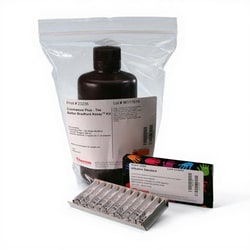Learn More
Thermo Scientific™ Pierce™ Bradford Plus Protein Assay Kits
Shop All Thermo Scientific ProductsDescription
The Pierce Bradford Plus Protein Assay Kit is a ready-to-use, reducing agent-compatible, improved Bradford assay reagent used to quickly measure total protein concentration compared to a protein standard. It provides increased linearity and half the protein-to-protein variability of other commercial Bradford assay formulations.
Kits are available with or without Pierce Dilution-Free BSA Protein Standards, which are a set of seven pre-diluted BSA standards, packaged in a multichannel pipette-friendly tubestrip. The tubestrip includes a single empty tube that enables users to add their own sample buffer for the purpose of blank subtraction.
The Pierce Bradford Plus Protein Assay Kit is a ready-to-use, reducing agent-compatible, improved Bradford assay reagent used to quickly measure total protein concentration compared to a protein standard. It provides increased linearity and half the protein-to-protein variability of other commercial Bradford assay formulations.
Kit options include Pierce Dilution-Free BSA Protein Standards, which are a set of seven pre-diluted BSA standards, packaged in a multichannel pipette-friendly tubestrip. The tubestrip includes a single empty tube that enables users to add their own sample buffer for the purpose of blank subtraction.
Features of the Pierce Bradford Plus Protein Assay Kit include:
- Colorimetric—measure with a standard spectrophotometer or plate reader at 595 nm
- Easy to use—single reagent; no working reagent preparation required
- Fast—almost immediate color development; add, mix, and read results
- Wide assay range—detects protein concentration in the range 1 to 1500 μg/mL
- Linear—improved linearity and response uniformity compared to traditional Bradford formulations
- Flexible—microplate and cuvette protocols provided and adaptable to several target working ranges
- Serial dilution–free—select kit options include Dilution-Free BSA Protein Standards that eliminate the need to perform serial dilutions when generating a standard curve
The assay is performed at room temperature. Simply add the sample to the tube or well containing reagent, and the resultant blue color is measured at 595 nm following a short room-temperature incubation. The protein assay is compatible with most salts, solvents, buffers, thiols, reducing substances, and metal-chelating agents encountered in protein samples. The assay can be performed in either test tube or microplate format.
How the Bradford Plus Assay detects protein
Use of Coomassie G-250 dye in a colorimetric reagent for the detection and quantitation of total protein was first described by Dr. Marion Bradford in 1976. In the acidic environment of the reagent, protein binds to the Coomassie dye. This results in a spectral shift from the reddish/brown form of the dye (absorbance maximum at 465 nm) to the blue form of the dye (absorbance maximum at 610 nm). The difference between the two forms of the dye is greatest at 595 nm, so that is the optimal wavelength to measure the blue color from the Coomassie dye-protein complex. If desired, the blue color can be measured at any wavelength between 575 nm and 615 nm. At the two extremes (575 nm and 615 nm) there is a loss of about 10% in the measured amount of color (absorbance) compared to that obtained at 595 nm.
Development of color in Coomassie dye-based (Bradford) protein assays has been associated with the presence of certain basic amino acids (primarily arginine, lysine, and histidine) in the protein. Van der Waals forces and hydrophobic interactions also participate in the binding of the dye by protein. The number of Coomassie dye ligands bound to each protein molecule is approximately proportional to the number of positive charges found on the protein. Free amino acids, peptides, and low molecular weight proteins do not produce color with Coomassie dye reagents. In general, the mass of a peptide or protein must be at least 3000 Daltons to be assayed with this reagent.

Specifications
Specifications
| Concentration | BSA: 2 mg/mL |
| Content And Storage | Sufficient For: 630 tube assays or 3160 microplate assays • Pierce Bradford Plus Assay Reagent, 950 mL • Albumin Standard ampules, 2 mg/mL, 10 x 1 mL Store Bradford Plus Assay Reagent at 4°C. Store unopened Albumin Standard ampules at room temperature. |
| Assay | Bradford Assay |
| Detection Method | Colorimetric |
| Product Line | Pierce |
| Product Type | Protein Quantitation Assay |
| Specificity | Not Target-Specific |
| Sufficient For | 630 Tube Assays or 3160 Microplate Assays |
| For Use With (Application) | Solution-based Detection, Absorbance |
| For Use With (Equipment) | Spectrophotometer, Microplate Reader |
| Show More |
Safety and Handling


- COOMASSIE PLUS PROTEIN ASSAY KIT
- Danger
- Skin corrosion/irritation Category 1 B
- Serious eye damage/eye irritation Category 1
- Specific target organ toxicity Category 2
- H314-Causes severe skin burns and eye damage.
- H371-May cause damage to organs.
- P280-Wear protective gloves/protective clothing/eye protection/face protection.
- P260-Do not breathe dust/fume/gas/mist/vapours/spray.
- P304+P340-IF INHALED: Remove person to fresh air and keep comfortable for breathing.
- P301+P310-IF SWALLOWED: Immediately call a POISON CENTER/doctor /
- P331-Do NOT induce vomiting.
- P303+P361+P353-IF ON SKIN (or hair): Take off immediately all contaminated clothing. Rinse skin with water/ shower.
- P311-Call a POISON CENTER/doctor/ .
- P305-IF IN EYES:.
- P310-Immediately call a POISON CENTER/doctor/.
- P501-Dispose of contents/container to .
- MIXTURE LIST-Contains : Phosphoric acid, Methyl alcohol
For Research Use Only.
Your input is important to us. Please complete this form to provide feedback related to the content on this product.
